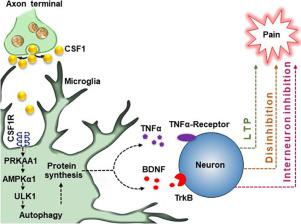当前位置:
X-MOL 学术
›
J. Neuroimmunol.
›
论文详情
Our official English website, www.x-mol.net, welcomes your
feedback! (Note: you will need to create a separate account there.)
The AMPK pathway triggers autophagy during CSF1-induced microglia activation and may be implicated in inducing neuropathic pain
Journal of Neuroimmunology ( IF 2.9 ) Pub Date : 2020-08-01 , DOI: 10.1016/j.jneuroim.2020.577261 Ge Yang 1 , Qian Tan 2 , Zhuoyang Li 3 , Kun Liu 2 , Jiangyan Wu 2 , Weihua Ye 2 , Haibo Mei 2 , Hui Yu 4
Journal of Neuroimmunology ( IF 2.9 ) Pub Date : 2020-08-01 , DOI: 10.1016/j.jneuroim.2020.577261 Ge Yang 1 , Qian Tan 2 , Zhuoyang Li 3 , Kun Liu 2 , Jiangyan Wu 2 , Weihua Ye 2 , Haibo Mei 2 , Hui Yu 4
Affiliation

|
The development and maintenance of neuropathic pain is now given far more attention in the clinic work. Increasing evidence has shown that colony-stimulating factor 1 (CSF1) is involved in microglial activation and may further induce pain. Here, we observed the signaling events that link the CSF1-induced microglial activated and consequences for pain processing. For the in vitro study, flow cytometry showed the microglial activity was markedly increased after CSF1 stimulation. Western blot showed the increased expression of p-PRKAA1/PRKAA1, p-AMPK/AMPK, p-ULK1/ULK1, p-S6k/S6k and LC3-II/LC3-I. QRT-PCR showed the IL-1, TNF-α and BDNF were simultaneously upregulated in the activated microglia cells, whereas the specific AMPK inhibitor compound C exhibited reverse effects in microglia. Using immunofluorescence staining and electron microscopy, we found CSF1 decreased microglial p62 expression and induced the number of autophagosomes, whereas compound C significantly exhibited the reverse effects. For the in vivo study, compared with the control and AMPK-siRNA transfection, the mice under CSF1 intrathecal injection increased CSF1 receptor and LC3 expressed in the activated spinal microglia. More importantly, qRT-PCR showed CSF1 intrathecal injection substantially upregulated BDNF and c-Fos mRNA expression as well as the ensuing neuropathic pain. Our findings demonstrated that CSF1 induced a significant upregulation of microglial activation via the AMPK signaling pathway and resulted in an increasing microglial autophagic level. An increasing CSF1 level in the central nervous system can mimic and cause pain syndromes by up-regulation of AMPK-depended autophagy, thus offering a new target for the therapy of neuropathic pain.
中文翻译:

AMPK 通路在 CSF1 诱导的小胶质细胞激活过程中触发自噬,并可能与诱导神经性疼痛有关
神经病理性疼痛的发展和维持现在在临床工作中得到了更多的关注。越来越多的证据表明,集落刺激因子 1 (CSF1) 参与小胶质细胞激活,并可能进一步诱发疼痛。在这里,我们观察到将 CSF1 诱导的小胶质细胞激活与疼痛处理后果联系起来的信号事件。对于体外研究,流式细胞术显示 CSF1 刺激后小胶质细胞活性显着增加。蛋白质印迹显示 p-PRKAA1/PRKAA1、p-AMPK/AMPK、p-ULK1/ULK1、p-S6k/S6k 和 LC3-II/LC3-I 的表达增加。QRT-PCR 显示 IL-1、TNF-α 和 BDNF 在活化的小胶质细胞中同时上调,而特异性 AMPK 抑制剂化合物 C 在小胶质细胞中表现出相反的作用。使用免疫荧光染色和电子显微镜,我们发现 CSF1 降低了小胶质细胞 p62 的表达并诱导了自噬体的数量,而化合物 C 则显着表现出相反的作用。对于体内研究,与对照和AMPK-siRNA转染相比,CSF1鞘内注射的小鼠增加了CSF1受体和激活的脊髓小胶质细胞中的LC3表达。更重要的是,qRT-PCR 显示 CSF1 鞘内注射显着上调 BDNF 和 c-Fos mRNA 表达以及随之而来的神经性疼痛。我们的研究结果表明,CSF1 通过 AMPK 信号通路诱导小胶质细胞活化的显着上调,并导致小胶质细胞自噬水平增加。中枢神经系统中增加的 CSF1 水平可以通过上调 AMPK 依赖性自噬来模拟和引起疼痛综合征,
更新日期:2020-08-01
中文翻译:

AMPK 通路在 CSF1 诱导的小胶质细胞激活过程中触发自噬,并可能与诱导神经性疼痛有关
神经病理性疼痛的发展和维持现在在临床工作中得到了更多的关注。越来越多的证据表明,集落刺激因子 1 (CSF1) 参与小胶质细胞激活,并可能进一步诱发疼痛。在这里,我们观察到将 CSF1 诱导的小胶质细胞激活与疼痛处理后果联系起来的信号事件。对于体外研究,流式细胞术显示 CSF1 刺激后小胶质细胞活性显着增加。蛋白质印迹显示 p-PRKAA1/PRKAA1、p-AMPK/AMPK、p-ULK1/ULK1、p-S6k/S6k 和 LC3-II/LC3-I 的表达增加。QRT-PCR 显示 IL-1、TNF-α 和 BDNF 在活化的小胶质细胞中同时上调,而特异性 AMPK 抑制剂化合物 C 在小胶质细胞中表现出相反的作用。使用免疫荧光染色和电子显微镜,我们发现 CSF1 降低了小胶质细胞 p62 的表达并诱导了自噬体的数量,而化合物 C 则显着表现出相反的作用。对于体内研究,与对照和AMPK-siRNA转染相比,CSF1鞘内注射的小鼠增加了CSF1受体和激活的脊髓小胶质细胞中的LC3表达。更重要的是,qRT-PCR 显示 CSF1 鞘内注射显着上调 BDNF 和 c-Fos mRNA 表达以及随之而来的神经性疼痛。我们的研究结果表明,CSF1 通过 AMPK 信号通路诱导小胶质细胞活化的显着上调,并导致小胶质细胞自噬水平增加。中枢神经系统中增加的 CSF1 水平可以通过上调 AMPK 依赖性自噬来模拟和引起疼痛综合征,











































 京公网安备 11010802027423号
京公网安备 11010802027423号